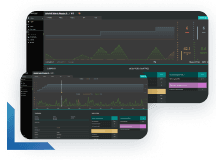
5 common challenges in continuous performance engineering
Top 5 challenges in continuous performance engineering—how NeoLoad ensures speed, scalability, and quality across delivery.

In today’s high-speed world of software delivery, performance engineering can’t afford to be a bottleneck. Teams are shifting left, moving fast, and integrating feedback loops earlier and more often, but performance feedback still too often lags.
If your performance testing still hinges on last-mile validations or project-based assessments, you’re not alone. Many teams are struggling with how to evolve their practices from siloed testing to scalable, integrated performance engineering. Below, we explore five of the most common challenges that organizations face in this transition and how leading teams are overcoming them.
1. Performance testing still happens too late
The challenge
Performance validation typically comes at the end of the cycle often after features are functionally complete. But discovering major performance regressions at the eleventh hour leads to costly rework, late-stage rework, and missed release deadlines.
Why it happens
Historically, performance testing has been a specialized function, with dedicated teams using heavyweight tools that don’t integrate easily with Agile and DevOps workflows.
How to overcome it
Begin embedding performance testing earlier starting with APIs. They’re easier to test, represent the backbone of most modern apps, and are often already defined in specs. Tricentis NeoLoad makes it easy to test APIs continuously, even before full environments or dependent services are ready, using service virtualization or mock services with API Simulation.
2. Manual test maintenance slows everything down
The challenge
Performance scripts break with every change. Legacy tools demand heavy lifting to keep up with evolving application logic, environments, or business processes.
Why it happens
Traditional performance testing approaches rely on brittle scripting models and static infrastructure that doesn’t reflect the dynamism of modern software delivery.
How to overcome it
Switch to tools that support automated script maintenance. NeoLoad uses dynamic updates and codeless test design, reducing script maintenance time by up to 75% compared to other legacy solutions. This not only speeds up delivery but also frees up your performance engineers to focus on strategy.
3. Lack of collaboration across teams
The challenge
Performance testing is often isolated from functional testing and development making it harder to share results, align on goals, or act on performance insights.
Why it happens
Performance engineering has traditionally lived in centers of excellence (CoEs), while product teams work in decentralized DevOps pods. Different tools, languages, and KPIs further widen the gap.
How to overcome it
Move toward shared responsibility. NeoLoad enables both experts and non-experts to contribute, integrating seamlessly with CI/CD. Combined with Tricentis Tosca and qTest, you get a unified, cross-team quality view with performance and functional insights in one place.
4. Perception that continuous performance testing slows down delivery
The challenge
Teams worry that embedding performance checks into every sprint will introduce delays or overhead that disrupt fast Agile cadences.
Why it happens
This concern stems from outdated testing practices, heavy, sequential workflows, and resource-intensive environments.
How to overcome it
When done right, continuous performance testing accelerates delivery. It prevents last-minute failures, provides real-time feedback, and reduces rework. NeoLoad’s ability to provision dynamic test environments and run tests in parallel pipelines eliminates traditional bottlenecks.
5. Too much reliance on a few experts
The challenge
Performance testing often depends on a small number of specialists, making scaling impossible and creating key-person risk.
Why it happens
Legacy tools demand deep scripting skills, and traditional performance testing is treated as a specialized effort rather than a team- wide capability.
How to overcome it
Modernize your tooling to empower more people. NeoLoad’s intuitive interface, RealBrowser testing, and low-code/no-code design means developers, QA, and even business stakeholders can understand and contribute. Teams adopting NeoLoad see test design time drop by 40% and test execution volumes increase 90x.
The path forward
Continuous performance engineering isn’t about testing more, it’s about testing smarter. It means automating early, making testing accessible, and integrating deeply with your software delivery pipelines.
At Tricentis, we’ve helped thousands of teams make this shift from reactive testing to proactive performance engineering. Whether you’re still relying on project-based validation or already embedding NeoLoad into your CI/CD pipelines, the most important step is forward.
To learn more about Tricentis NeoLoad and how to start testing today, take a look at our product tour.

